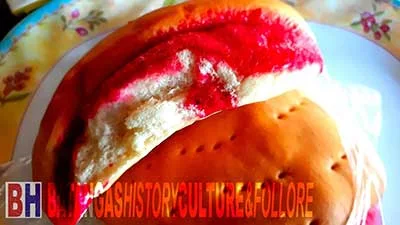[Culture: Food] The “Pulang Kiki” Bread of Western Batangas
Back in the sixties, there was this story in the western Batangas coastal town of Nasugbu of an old lady in a calesa (a horse-drawn carriage) asking the kutsero (driver) to stop in front of a panaderia (bakery) and then matter-of-factly hollering, “Ineng, sampung pisong pulang-kiki nga!” (Girl, ten pesos pulang kiki please!)
Now the young lady manning the bakery would just as matter-of-factly pick out ten pesos’ worth of pulang kiki from the racks, place these inside a small brown paper bag, saunter over to the calesa, hand over the paper bag, collect the ten pesos and nonchalantly return to the bakery.
Even the kutsero was poker-faced, obviously thinking nothing extraordinary about the exchange.
Except that what the old lady hollered for all and sundry to hear, translated literally, was “red vagina.” And this was the sixties, an era when private parts were things that you whispered to somebody, not shout out loud for all the world to hear.
In the old lady’s defense, the pulang kiki was nothing — at least directly — sexual at all. All she called for was ten pesos’ worth of this soft puffy bread with a “distinctive, vibrant red-colored filling1.” It is the way the rest of the bread wraps around the red filling that, one supposes, inspired the bawdy name.
In hindsight, whoever first thought of baking this bread really ought to have known better. Truth be told, the bread does indeed look like, well, female private parts. The name pulang kiki, apparently, is used in other western Batangas towns as well, although not really in eastern Batangas.
In other Tagalog-speaking localities, they are even more irreverent, calling the bread pan de regla (menstruation bread). Why this is so, apparently, is because someone thought the bread looked like a piece of used sanitary napkin2. That is one explanation, anyway, and why anyone would want to give food — any food — such a gag-inducing name is difficult to understand.
To think that the bread’s legitimate name is the totally innocuous kalihim. Translated into English, the word is “secretary, a confidante3,” or a “keeper of secrets.”
Not that the so-called “secret” is anything to be scandalized about. It is said that the secret to the kalihim is that the sweet red filling which has inspired so many bawdy nicknames is actually made with the previous day’s bread4.
2 “The Secret History Behind Pan de Regla and Other Panaderia Eats,” by Serna Estrella, online at Pepper.
3 Translations from TagalogTranslate.
4 Estrella, op cit.

